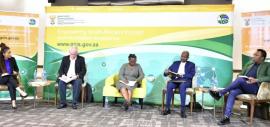
Despite a myriad of challenges – both present and past – along the way, the South African government through Eskom and municipalities has made great strides towards achieving universal access to electricity in the country.
This came out during a roundtable on the electrification programme since 1994 hosted by the Government Communication and Information System (GCIS).
According to the Eskom website, in 1987, fewer than 13 million people had access to electricity with the vast majority of that access servicing white households – leaving other population groups reeling in the dark.
At the dawn of democracy in 1994, Parliament endorsed a plan to create universal access to electricity – defined at some 97% due to population growth and challenges related to the formalisation of informal settlements.
This charged government’s wholesale plan to electrify homes. Now, access to electricity in South Africa today is at least 94% according to Statistics South Africa.
Director Project Monitoring and Intergovernmental Relations at the Department of Mineral Resources and Energy, Lufuno Madzhie, said the electrification programme has thus far, been a success.
“[During 1994 to 1998] Eskom and municipalities only electrified 2.5 million households. In 2001, then government decided this [electrification] programme needs to reside within the Department of Mineral Resources and Energy [DMRE]. Through us as the department, working with different stakeholders, we have achieved a lot with regard to this electrification programme.
“Through this programme, the department has achieved a huge milestone. Currently, we have electrified over 8.3 million households,” he said.
Eskom’s Pozisa Njezula emphasised how access to electricity improves the welfare of households and explained how Eskom contributes to facilitating access for hard-to-reach rural areas.
“[It allows for the] improving on safety where we no longer have to use candles and paraffin stoves. It improves on convenience where we no longer have to collect wood to cook and also, in terms of improving on education where kids can study at night.
“With…us now pushing towards universal access, the challenge that we are now faced with is that we now have to reach the far-flung areas. The far corners in all the rural areas. With the support from the DMRE, as Eskom we have started and embarked on the rolling out of micro grids for those far-flung areas where you may not be able to get grid electricity because of losses as well as the amount of money that you would have to spend to get to those areas.
“The [micro grid] is just a container, it has solar panels, it has got batteries and then you’ve got the reticulation network. When you get to a certain area, you electrify it off grid and those people benefit,” she said.
Challenges and solutions
Njezula bemoaned that although the electrification programme is going full steam ahead, the power utility faces serious and dangerous challenges when going into communities.
“We are not immune as Eskom to the crime [and] extortion in our project sites. In South Africa, with almost all the projects that are being undertaken, there’s reports of these extortions and these demands for certain amounts of money, for protection fees and so forth.
“That delays the progress in our projects, and it really puts the lives of our employees as well as our contractors in danger. In some instances, we have to leave site, we need to be escorted, we need protection,” she said.
Head of energy and electricity distribution at the South African Local Government Association, Nhlanhla Ngidi, described South Africa’s electrification plan as a “moving target”.
“In terms of access itself, at 94%, I think it’s very important that people understand because this is a moving target. In a year’s time, you could find this being below 94% and it’s because of all these challenges…people moving towards where the economy is more active.
“Municipalities have done quite well but with the capacity challenges we have, we still need municipalities to be assisted and government needs to put in place agencies that can come in and be catalysts in terms of the implementation of the programme,” he said.
Energy expert, Chris Yelland, agreed that access to electricity has improved but warned that affordability remains a blockage to some households.
“[There] are some technology developments that require that we look at these distant rural customers. The first thing of course is renewable energy. The price of renewable energy…has come down dramatically over the last ten years. This is now opening the doors to renewable energy for remote households that never existed ten years ago.
“There’s a lot to celebrate in electrification [but] there’s a lot to do about affordability. We are not there yet. We need to understand where we come from, where we are and where we’re going and for that we need data…so that we know where we are and where we’re going” he said. – SAnews.gov.za


